I successfully rooted a Florida dogwood (Cornus florida) from a cutting! This is a tree that’s been tricky in the past for me to propagate, and I finally had some success I think is worth sharing.
In this post, I’ll walk you through exactly what worked, step-by-step instructions for how to root flowering dogwood cuttings yourself, and some tips and tools that made all the difference; especially an upgraded rooting hormone that really seemed to help get some roots started.
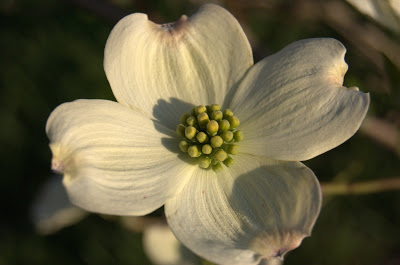
I may earn a small commission if you purchase through some of the links in this post at no extra cost to you. I only recommend products I use and trust!
Why Dogwoods Are Tricky to Root
Red twig dogwoods are pretty easy to root but Florida dogwoods (Cornus florida) are much more difficult. Many of the cultivars you purchase at the nurseries tend to be grafted trees on seed grown root stock. Growing dogwoods from seed is actually a pretty easy process. I’ve tried cuttings before with little success, but this time I made a few changes to my usual approach. In particular:
- Timing: I used greenwood cuttings taken in early summer.
- Medium: I used a sand and coco coir mix for good drainage and moisture retention.
- Rooting Hormone: I switched to a much stronger rooting hormone – more on that below.
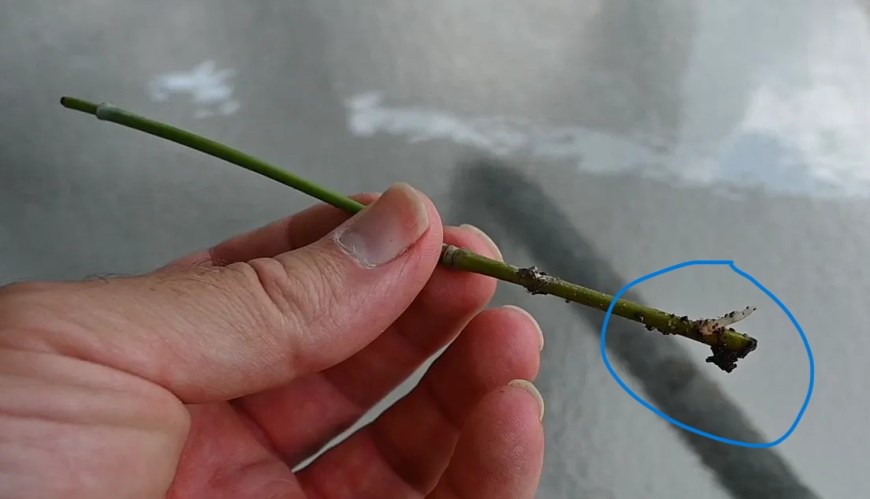
Rooting Hormones: Why I Switched to Hormodin 3
Most gardeners use something like the Garden Safe TakeRoot Rooting Hormone, which contains 0.1% indole-3-butyric acid (IBA). That’s a synthetic plant hormone that helps cuttings grow roots. This concentration is easy to find at your local hardware stores or online.
Florida dogwoods are tougher to root, and that lower concentration just wasn’t working well enough to produce roots.
I upgraded to Hormodin 3, which contains 0.8% IBA – eight times stronger than TakeRoot. TakeRoot is still great for easier to root plants, perennials, shrubs, and some trees but the .1% IBA isn’t enough for some more challenging plants.
Here’s a link to the rooting hormone I used:
When sticking cuttings use a clean jar or container to dip the cuttings in and don’t dip directly into the original Hormodin jar to avoid possible contamination.
Materials I Used
- Pruners (clean and sharp)
- Yogurt cups (with holes punched for drainage. You can use any plastic container that will hold a rooting medium and water.)
- Rooting medium: mix of sand and coco coir
- Hormodin 3 rooting hormone
- Paintbrush handle or dibber (to pre-make holes)
- Water jar (to hold cuttings while prepping)
Step-by-Step: How to Root Dogwood Cuttings
Here’s exactly how I rooted my Cornus florida cuttings.
1. Pick the Right Time and Material
- Take greenwood cuttings in early morning during early to mid-summer.
- Choose stems that are 4–5″ long with at least three leaf nodes.
2. Prepare the Cuttings
- Cut just below a leaf node.
- Remove all but the top leaf.
- Optionally, wound the base by gently scraping the bark to expose the cambium layer—this can increase root formation.
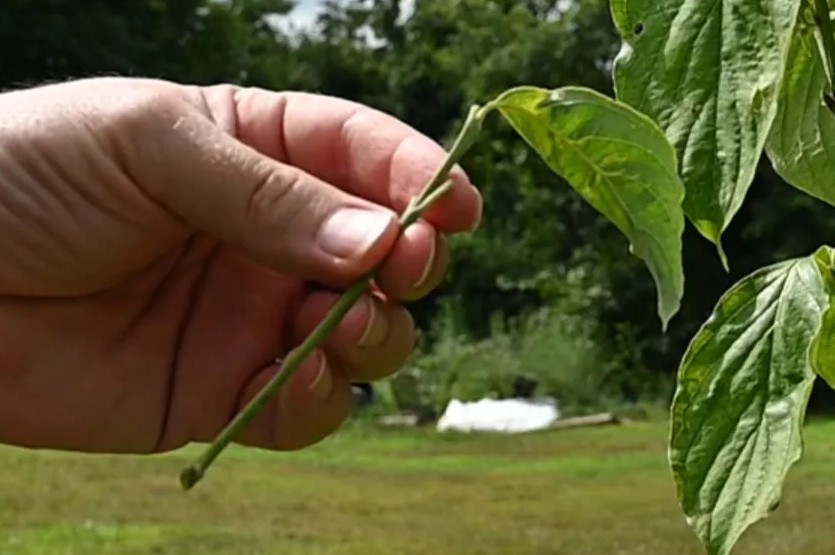
3. Dip in Rooting Hormone
- Dip the base in rooting hormone and tap off any excess.
- Pre-make a hole in your rooting medium to avoid wiping off the hormone when planting. I used a kids paint brush handle to do this. A pencil, pen, or even just a stick and work for a dibber.
4. Plant in Medium
- Stick the cuttings into a container filled with pre-moistened sand and coco coir mix.
- Firm the medium around the base so it has good contact.
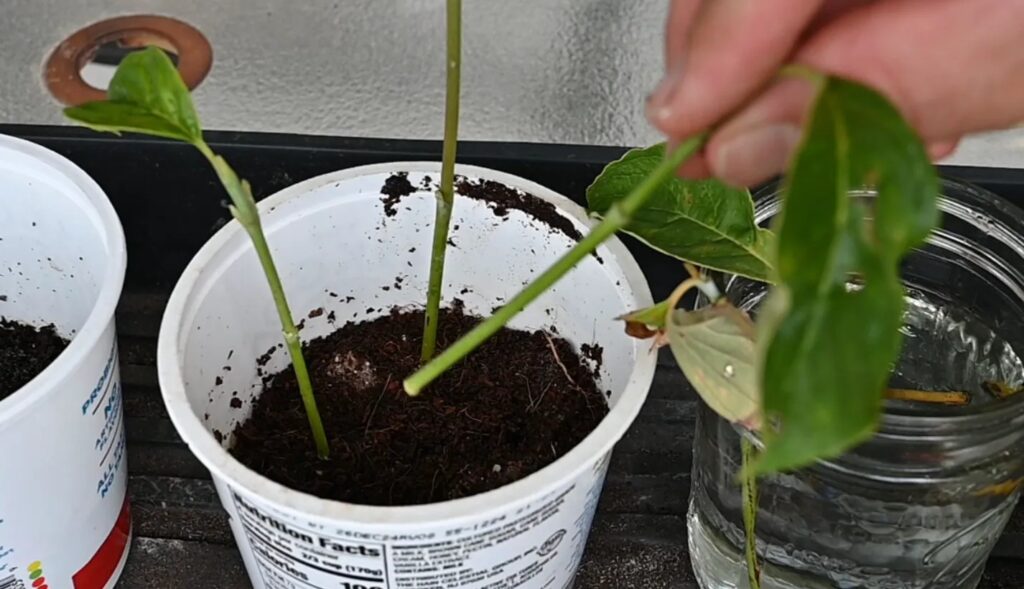
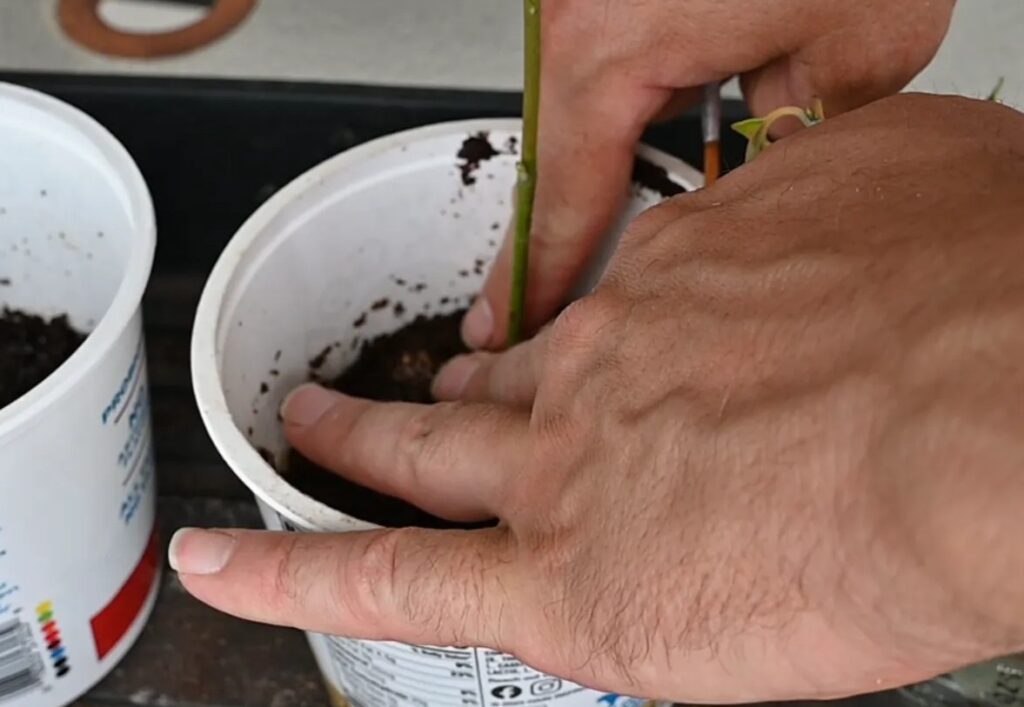
5. Provide the Right Environment
- Keep the cuttings out of direct sun – you can use shade or grow lights.
- Mist regularly, especially during hot weather.
- Maintain high humidity around the cuttings. You can cover the cuttings with a tented plastic bag or use regular misting to keep the humidity high.
Here’s my walkthrough video on How I Rooted the Dogwood Cuttings:
Dogwood Cutting Success Rate
Out of three cuttings I originally took, only one rooted – but that was still a win. Now I’m trying again with four more cuttings, hoping to improve my success rate with the same method.
For more information on propagating trees and shrubs I highly recommend this book by Michael A. Dirr and Charles W. Heuser Jr. The Reference Manual of Woody Plant Propagation. It has case studies for a lot of different types of plants and is extremely useful in my library of gardening books. It is an absolute MUST HAVE if you enjoy plant propagation! You can find some really good prices for it as a used book.
Bonus Tips for Better Rooting
- Always use clean tools to avoid disease.
- Take cuttings early in the day while moisture content is high.
- Hydrate your tree the day before taking cuttings.
- Use well-drained but moisture-retentive medium (sand + coco coir is my favorite right now).
- Label your containers—especially if you’re experimenting with different hormone strengths.
Final Thoughts
Rooting dogwoods, especially Cornus florida, isn’t the easiest propagation project—but it is possible with the right tools and timing. I’ll keep experimenting and report back with more updates. While I’m happy with 1 more than I had I would really love to get several more dogwood trees going to plant around our property.
If you’ve had success rooting dogwoods, I’d love to hear about your methods. And if you’re trying this for the first time, let me know how it goes!
Happy propagating!
How to Propagate Pyracantha (Firethorn)
While out of town this past weekend at my in-laws home I took the opportunity to take more cuttings from their pyracantha (Pyracantha augustifolia). It is a favorite of shrub for birds due to its bright orange berries and is has an appropriately named common…
Garden Shed Plant Propagation Update
This year was the first year I’ve been able to house my cuttings in the garden shed. It’s been great so far. There’s no heat but the plants have been protected from the coldest of the winter lows. Essentially I’ve moved them 1-2 heat zones…
Float Testing Acorns for Viability
The majestic oak is one of Tennessee’s most beautiful native trees. It’s also an extremely useful tree for our local wildlife as it can host over 200 species of insects and animals. You can see why you would want to cultivate more oak trees! Recently…
How to Propagate Leyland Cypress from Cuttings
Plant propagation can continue at almost every time of the year, the winter is no exception. This is especially true if you have a little space in your house to put your cuttings or can manage to manipulate them into interesting centerpieces! In this post…
Coral Red Honeysuckle (Lonicera sempervirens)
Coral Red honeysuckle or Lonicera sempervirens is the honeysuckle you want – I mean really want- not the other kind. You probably have honeysuckle somewhere near you right now. It’s white, smells pretty good, and it may even be right behind you as you read…
5 Easy To Propagate Plants from Cuttings
One of my greatest gardening pleasures is that of making a new plant, for free! Well I don’t actually do the work the plant does, but knowing how to give the plant the optimum conditions for rooting is important for success! The plants I’m listing…
Discover more from Growing The Home Garden
Subscribe to get the latest posts sent to your email.








